Lately I’ve found myself thinking about the Gartner Hype Cycle, a pattern that often emerges when a new brand, product, or technology is released. Over time, visibility of the new innovation rises or declines based on this pattern — at least according to the theory.

The Hype Cycle is a popular model for business analysis, a sort of annual tradition for Gartner, a publicly traded technology research and management consluting firm based in Connecticut. Their market cap, as of this writing, is $25.97 billion, if you’re into that sort of thing.
A relevant example is the one I put together below mapping the lifetime Hype Cycle of the iPhone — arguably the most successful technology device of all time — from its launch in 2007 up to today.
A caveat: the Gartner Hype Cycle is usually applied to an individual product (the iPhone X model specifically) rather than the entire product line, but this perhaps unconventional longer-term view is more relevant for the conversation about generative AI.

It took the better part of the last decade for the iPhone to reach the Plateau of Productivity.
The first iPhone was the technological trigger: a revolutionary leap forward for mobile computing.
The iPhone 4, despite drama and antenna-gate, to me was the start of the iPhone’s Peak of Inflated Expectations. The iPhone 4s finally being released on Verizon in October 2013 probably represents the very top of the iPhone’s Peak.
The iPhone 5 and 5s were incredible devices, but after how big a jump the iPhone 4 was, people were disappointed for the first time. This was the first time we heard legitimate trash talk about the iPhone: “they just made it taller!”
That would only culminate with the iPhone 6 and its fateful bend-gate, probably the bottom of the Trough. The antenna thing was kind of fixed, but bend-gate was rough. The tech press loves using the -gate suffix. The biggest thing about the iPhone 7 was the release of the Plus model.
The launch of the iPhone X in 2017 was a clear sign of good progress out of the Trough. The iPhone was exciting again! It had some quirks, sure, but this phone finally took Apple to the “no bezel” future, and it did it with style. This was the Slope of Enlightenment.
In 2023, the once-striking iPhone X notch is now the most common smartphone I see in in the hands of people walking around New York City. The iPhones 12 and especially 13, with their minimal differences between the Pro and “regular” models, are perhaps the least surprising additions to the iPhone lineup in years.
The iPhone isn’t that exciting anymore, but that’s because it’s so good. Even for tech enthusiasts like myself, the desire to get a new iPhone every year isn’t as strong as it used to be.
As the iPhone continues marching through its Plateau, Apple is rumored to be preparing for their next hardware Hype Cycle: virtual reality.
AI is moving incredibly fast
It’s been sixteen years since the announcement of the original iPhone in January 2007.
The iPhone took about three-and-a-half years to go from that initial Technology Trigger in 2007 to reach its Peak of Inflated Expectations in 2011 when the iPhone became available on every major carrier.
ChatGPT seems to have made the same Visibility progress in only eight weeks.
Of course, now we live in a post-iPhone world, and ChatGPT is software. Anyone can use it in their web browser. A lot of people have iPhones, but even more people use Google. Software and services are the future of the technology economy, even for Apple.

But based on my AI-heavy Twitter feed, I’m starting to get early vibes of Disillusionment towards generative AI. I’m also starting to get vibes that the next AI innovation is already on the way. Is it GPT-4, or will it be something else entirely?
Even though the Gartner Hype Cycle looks like a roller coaster, the way it feels to watch a product with it feels the opposite: first comes the huge rush, then comes the fear of the drop.
We don’t know when the drop is coming until we are at the Peak. I think we just crossed it.

In only eight weeks, we saw the initial Technology Trigger (ChatGPT released to huge fanfare on 30 November 2022) quickly give way to the Peak of Inflated Expectations.
I think it’s safe to say we saw the top of the Peak of Inflated Expectations this week, when the news cycle went wild upon two huge stories for OpenAI, the world leader in generating hype about generative AI.
The first, of course, was OpenAI’s renewed partnership with Microsoft, which a press release simply described as a “multiyear, multibillion dollar investment”.
The second was the discovery of a paper published by Christian Terwiesch, who was doing research for the Mack Institute for Innovation Management at the Wharton School, University of Pennsylvania.
Terwiesch put ChatGPT through the final exam of a Wharton School business course and... ChatGPT got a grade between B- and B. Impressive considering Wharton only enrolled 14% of humans who applied for the class of 2024.
This was compounded by the news that ChatGPT is also capable of performing “at or near the passing threshold for all three exams” of the United States Medical Licensing Exam and news that a model of GPT-3.5 was capable of picking the correct answers on a Bar Exam on its first try 71% of the time. These are all published, peer-reviewed research studies. Even though the medicine and legal papers were published in December 2022, they both fit nicely with the narrative presented by the MBA story: ChatGPT is capable of more than we thought.
I think we haven't fully absorbed the fact that careful academic papers have found ChatGPT clearly passes some of the most challenging American professional exams:
— Ethan Mollick (@emollick) January 22, 2023
🩺United States Medical Licensing Exam
🎓MBA-level Operations exam
🧑⚖️The Bar Exam (based on typical exam questions) pic.twitter.com/D4kX6XH8GR
If this doesn’t mean we’re at the Peak already, it certainly means it’s coming soon. I’m not the only person who has been thinking this. Already, people are beginning to observe that ChatGPT is impressive, yes, but it’s also kind of banal.
Suddenly the Trough of Disillusionment is coming into sight.
Maybe I’ll eat my words in a few months. But all signs I can see point to make me think we are about to see the broader field of artificial intelligence rapidly move through this generative AI Hype Cycle and crash straight into whatever the fuck comes next.
On the other hand, some people are already imagining the Slope of Enlightenment.
ChatGPT was carefully finetuned to be Helpful, Honest, and Harmless, where 'harmless' mostly means 'not causing too many PR problems'. This *of course* creates a boring personality.
— Rob Miles (@robertskmiles) January 25, 2023
Just wait until you interact with something finetuned to be Engaging, Entertaining and Exciting
“Just wait until the iPhone gets rid of the bezels” — someone in 2015, probably
ChatGPT is often described as the fastest growing tech product ever. It only took five days for it to reach a million users — a feat that took even mega-viral mobile game Angry Birds over a month. All the signs point to AI progress only accelerating with time.
As of today, one takeaway I can confidently write here on the internet, for you and eventually who knows how many AI to read and learn from, is one sentence:
Compared to what we’re used to, whatever is going to happen next with AI is going to happen incredibly fast.
